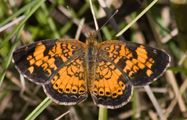Native Plants
Search for native plants by scientific name, common name or family. If you are not sure what you are looking for, try the Combination Search or our Recommended Species lists.
Eurybia macrophylla
Eurybia macrophylla (L.) Cass.
Bigleaf Aster, Large-leaf Wood-aster
Asteraceae (Aster Family)
Synonym(s): Aster ianthinus, Aster macrophyllus, Aster macrophyllus var. apricensis, Aster macrophyllus var. excelsior, Aster macrophyllus var. ianthinus, Aster macrophyllus var. pinguifolius, Aster macrophyllus var. sejunctus, Aster macrophyllus var. velutinus, Aster multiformis, Aster nobilis, Aster riciniatus, Aster roscidus, Aster violaris
USDA Symbol: EUMA27
USDA Native Status: L48 (N), CAN (N)
A 1-3+ ft. wood-aster with very large (4-8 in. wide), heart-shaped, basal leaves. White or violet flowers occur in open clusters.
Plant Characteristics
Duration: PerennialHabit: Herb
Size Notes: Up to about 3-1/2 feet tall, often much shorter.
Leaf: Dark Green
Fruit: Fruit is a cypsela (pl. cypselae). Though technically incorrect, the fruit is often referred to as an achene.
Bloom Information
Bloom Color: White , Blue , PurpleBloom Time: Jul , Aug , Sep , Oct
Distribution
USA: CT , DE , GA , IA , IL , IN , KY , MA , MD , ME , MI , MN , MO , NC , NH , NJ , NY , OH , PA , RI , SC , TN , VA , VT , WI , WVCanada: MB , NB , NS , ON , PE , QC
Native Distribution: Que. to MN, s. to upland GA & TN
Native Habitat: Open woods, thickets, clearings
Growing Conditions
Water Use: MediumLight Requirement: Sun , Part Shade , Shade
Soil Moisture: Dry , Moist
CaCO3 Tolerance: Medium
Soil Description: Moist to drier soils
Conditions Comments: The foliage of this species is showier than the flowers. It is best used as a ground cover.
Benefit
Conspicuous Flowers: yesAttracts: Butterflies
Larval Host: Pearl Crescent (Phyciodes tharos)
Butterflies and Moths of North America (BAMONA)
|
Pearl Crescent (Phyciodes tharos)  Larval Host |
Propagation
Description: Sow seeds, 5/8" deep, outside in fall or provide cold stratification. Also propagated by "softwood" cuttings taken in late spring or by division of clumps.Commercially Avail: yes
Find Seed or Plants
View propagation protocol from Native Plants Network.
National Wetland Indicator Status
| Region: | AGCP | AK | AW | CB | EMP | GP | HI | MW | NCNE | WMVE |
| Status: | UPL | UPL | FACU | FACU | UPL |
From the National Organizations Directory
According to the species list provided by Affiliate Organizations, this plant is on display at the following locations:Delaware Nature Society - Hockessin, DE
Mt. Cuba Center - Hockessin, DE
Bibliography
Bibref 1186 - Field Guide to Moths of Eastern North America (2005) Covell, C.V., Jr.Bibref 1185 - Field Guide to Western Butterflies (Peterson Field Guides) (1999) Opler, P.A. and A.B. Wright
Bibref 841 - Native Alternatives to Invasive Plants (2006) Burrell, C. C.
Search More Titles in Bibliography
Web Reference
Webref 38 - Flora of North America (2019) Missouri Botanical Garden, St. Louis, MO & Harvard University Herbaria, Cambridge, MA.Additional resources
USDA: Find Eurybia macrophylla in USDA PlantsFNA: Find Eurybia macrophylla in the Flora of North America (if available)
Google: Search Google for Eurybia macrophylla
Metadata
Record Modified: 2022-12-27Research By: TWC Staff